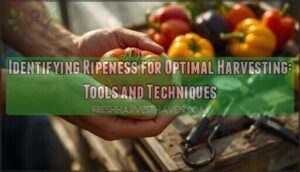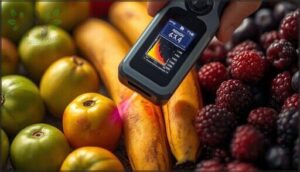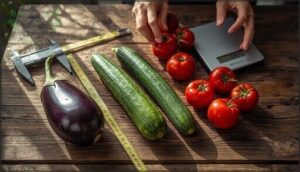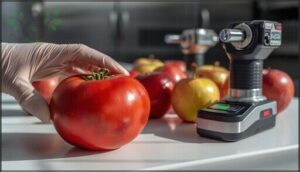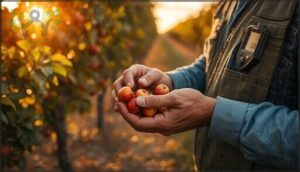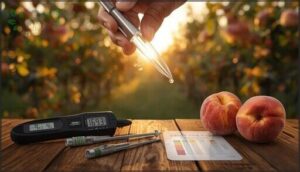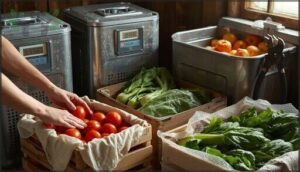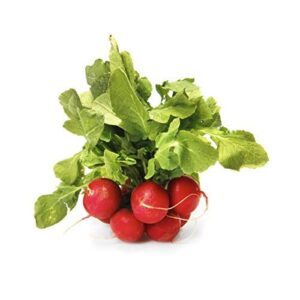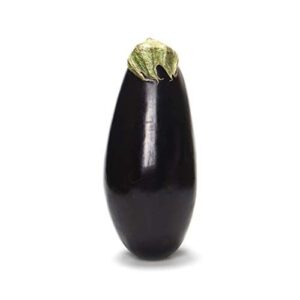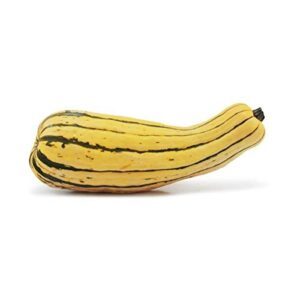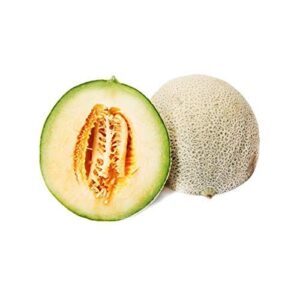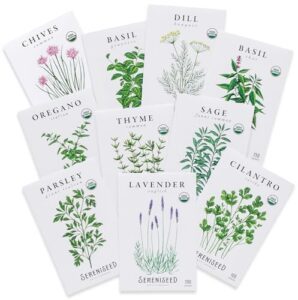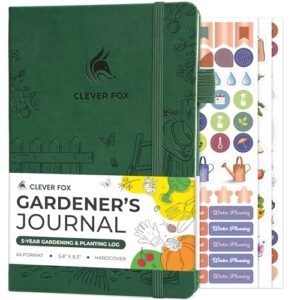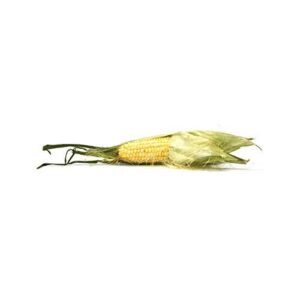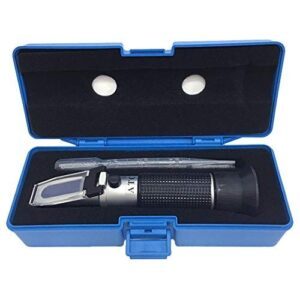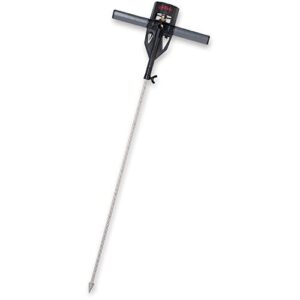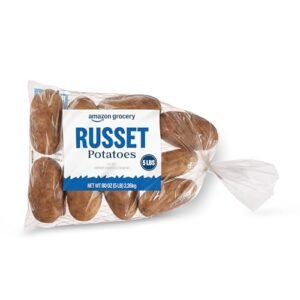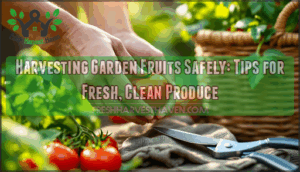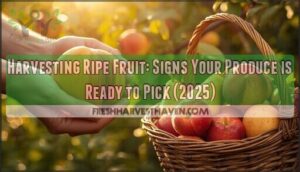This site is supported by our readers. We may earn a commission, at no cost to you, if you purchase through links.
Picking a tomato too early leaves you with hard, flavorless fruit that never fully ripens on the counter. Wait too long, and you’re dealing with splits, rot, and wasted effort.
The difference between a mediocre harvest and peak-quality produce often comes down to recognizing the subtle cues that signal readiness—color shifts, texture changes, and aromatic hints that vary across crops.
Identifying ripeness for best harvesting isn’t guesswork anymore. Modern tools like Brix refractometers and hyperspectral imaging now quantify what experienced growers once knew only by touch and intuition. Combining these technologies with proven manual techniques transforms your timing, cuts losses, and ensures every piece of produce reaches its full potential before leaving the field.
Table Of Contents
- Key Takeaways
- Key Indicators of Ripeness for Harvesting
- Best Timing for Optimal Harvest
- Tools and Techniques for Ripeness Assessment
- Post-Harvest Handling to Preserve Ripeness
- Top 10 Tools and Products for Ripeness Identification
- 1. Root Radish Red Organic Fresh Bunch
- 2. Fresh and Flavorful Eggplant One Pound
- 3. Organic Fresh Delicata Winter Squash
- 4. Fresh and Sweet Cantaloupe Melon
- 5. Sereniseed Organic Herb Seed Variety Pack
- 6. Clever Fox 5 Year Garden Journal
- 7. Fresh Bi Color Sweet Corn
- 8. Brix Refractometer Dual Scale Homebrew Kit
- 9. AgraTronix Soil Compaction Tester Made USA
- 10. Amazon Grocery Russet Potatoes 5 Lb
- Frequently Asked Questions (FAQs)
- Conclusion
Key Takeaways
- Timing your harvest by combining color shifts, texture changes, and aroma cues—plus modern tools like Brix refractometers and hyperspectral imaging—cuts losses and ensures produce reaches peak quality before leaving the field.
- Morning harvesting reduces field heat by up to 22% and preserves moisture better than afternoon picking, though afternoon harvest boosts sugar content by 38% in some crops, so match your timing to market demands and crop biology.
- Post-harvest handling matters as much as picking time—delaying cooling by just one hour costs a full day of shelf life, while proper ethylene management and temperature control extend storage by 2–15 days depending on the crop.
- Non-destructive technologies like near-infrared spectroscopy and hyperspectral imaging now achieve 98–99% accuracy in ripeness assessment, but manual techniques like gentle pressure testing and the lift-and-twist method still reduce bruising by 15–18% and remain essential for field validation.
Key Indicators of Ripeness for Harvesting
Knowing when to harvest isn’t guesswork—it’s about reading the clear signals your crops give you. Each fruit and vegetable tells its own story through specific physical changes that reveal peak ripeness.
Let’s break down the four primary indicators you’ll rely on to time your harvest perfectly.
Color Changes in Fruits and Vegetables
As chlorophyll breaks down during ripening, you’ll see green fade into vibrant yellows and oranges as carotenoid accumulation takes over. Anthocyanin formation drives reds and purples in berries, responding to light and temperature shifts.
These color changes aren’t just visual cues—they’re measurable ripeness indicators. Spectral measurement tools can quantify these transformations, helping you pinpoint harvest readiness with precision despite environmental influences. This is because ethylene production regulates fruit ripening.
Size, Shape, and Surface Characteristics
Beyond color, you need to assess size standardization and shape uniformity for harvest readiness. Well-formed cucumbers remain straight and only slightly tapered, while surface texture reveals maturity—eggplants develop tight, glossy skin when ready. Visual inspection and tactile testing uncover surface defects that signal poor timing. International standards classify produce by weight measurements.
Consider these grading standards:
- Apples average 71.13 mm at harvest
- U.S. Fancy cucumbers reach 6+ inches
- Tomatoes fit standardized box dimensions
- Density indicators confirm internal development
Texture and Firmness Assessment
Texture cues matter as much as appearance. Gentle pressure reveals readiness—ripe tomatoes yield slightly, while firm apples destined for storage need at least 15 lbs penetrometer accuracy.
Tactile testing offers immediate feedback on firmness and resistance. Digital testers and acoustic firmness methods now achieve 92% accuracy, while LDV estimation provides contactless measurements.
These texture indicators for ripe fruit help you meet firmness standards without guesswork.
Aroma and Flavor as Ripeness Signals
You’ll notice sweet aromas intensify as ripeness peaks—strawberries produce up to 979 volatile compounds at peak maturity. Sensory evaluation confirms flavor phenotypes shift dramatically: esters peak in ripe fruit, then decline sharply.
Aroma profiles serve as reliable ripeness markers, with methyl hexanoate peaking at full maturity while flavor development follows predictable patterns. The ripening process transforms bland fruit into aromatic treasure worth harvesting.
Best Timing for Optimal Harvest
Getting the timing right can make or break your harvest. You can’t just pick fruit whenever it’s convenient and expect top-quality results.
Harvest timing isn’t a matter of convenience—it’s the difference between peak quality and mediocre results
Let’s look at the key timing factors that separate a mediocre harvest from a superior one.
Morning Vs. Afternoon Harvesting
Harvest timing affects fruit quality more than you might expect. Cooler morning hours reduce field heat by up to 22%, slowing respiration and preserving moisture that keeps produce crisp. Morning-picked vegetables retain 15% more water and show 9% lower spoilage rates.
However, afternoon harvesting boosts sugar content—forage cut later contains 38% more water-soluble carbohydrates.
Your diurnal harvest strategy should match your crop yield goals and market requirements for peak ripeness.
Seasonal Considerations (Spring, Summer, Autumn)
Each harvest season brings distinct ripeness demands. During spring planting, you monitor frost-tolerant crops like onions and artichokes for ideal maturity signals.
Summer pruning requires daily checks—squash and tomatoes peak quickly in warm conditions.
Autumn harvesting focuses on root vegetables and grains, where post-frost timing enhances sweetness.
Understanding seasonal harvesting guidelines and fruit maturity patterns across harvest time ensures you capture peak quality for every seasonal crop.
Impact of Weather and Climate on Ripeness
Beyond seasonal cycles, weather patterns directly govern ripening speed and harvest timing. Temperature effects dominate—raising heat from 14°C to 30°C can cut maturity time by 40%, while climate trends show grape harvests advancing 7–14 days per decade.
Rainfall anomalies delay fruit ripeness by sustaining acidity, and extreme heat triggers premature softening, reducing yields up to 40% in sensitive crops.
Scheduling Regular Ripeness Checks
Ripeness monitoring isn’t a once-and-done task—it demands rhythm and precision. Consistent checks cut postharvest losses up to 30%, particularly with fast-ripening berries and tomatoes that require twice-daily assessments during peak periods.
- Missing the harvest window by just one day reduces shelf life by 15–25%
- Automated systems check ripeness every 6–8 hours, maintaining 90%+ accuracy
- Climacteric fruits hit peak ethylene release 48–72 hours before ideal harvest timing
- Combining manual validation with sensors boosts harvest accuracy by 20–25%
Tools and Techniques for Ripeness Assessment
You can’t rely on guesswork regarding harvesting fruit at peak ripeness. The right tools give you accurate, real-time data that takes the uncertainty out of your timing decisions.
From measuring sugar levels to using sophisticated sensors, here’s what you need to know about the most effective assessment methods.
Using Brix Refractometers for Sugar Content
You can measure internal sugar content with surprising precision using a Brix refractometer—a portable tool requiring just one drop of juice. Digital models like the HI96801 deliver readings in 1.5 seconds with automatic temperature compensation. Target Brix levels guide harvest optimization: 8–12 is good, while 14+ signals excellent fruit quality and premium pricing potential.
| Crop | Target Brix Level |
|---|---|
| Tomatoes | 6–8 |
| Sweet Corn | 14–18 |
| Grapes | 19–25 |
| Watermelon | 10–12 |
| Lettuce | 8+ |
Non-Destructive Technologies (Sensors, Imaging)
Modern sensors can “see inside” your fruit without cutting it open. Hyperspectral imaging systems achieve 99% accuracy in ripeness classification, while near-infrared spectroscopy predicts sugar content within 0.3° Brix. Machine learning models now reach 98.5% accuracy identifying internal quality through smartphone imaging.
- Electronic nose technology detects volatile compounds with over 90% accuracy in milliseconds
- Portable NIR analyzers measure soluble solids in field conditions with lab-grade precision
- Machine vision systems assess color, texture, and firmness simultaneously without touching produce
Manual Techniques: Lift, Twist, and Cut
While sensors offer speed, your hands remain irreplaceable. Apply gentle pressure to assess texture cues—ripe tomatoes yield slightly under your thumb. The lift and twist method minimizes bruising by 15% in berry harvests, preserving natural break-points. Cutting tools reduce microbial spoilage by 12% in cucurbits.
These harvest efficiency practices extend shelf life by 2-5 days through proper fruit handling and post-harvest care.
| Technique | Best For | Damage Reduction |
|---|---|---|
| Lift & Twist | Stone fruits, berries | 15-18% fewer bruises |
| Cut | Eggplants, squash | 12% less spoilage |
| Gentle pressure | Tomatoes, avocados | 92% selection accuracy |
Selecting and Maintaining Harvest Tools
Beyond technique, your tools make or break harvest efficiency. Prioritize ergonomic grips between 1.38 and 2.13 inches in diameter to reduce strain-related injuries—musculoskeletal disorders account for 31% of agricultural injuries. Sharp blades improve energy efficiency by 14–18% while cutting operator fatigue by 22%. Weekly cleaning and daily lubrication during peak seasons prevent 40% of breakdowns.
- Rubber grips reduce slippage risk by 45% during handpicking
- Stainless steel tools last 40% longer under identical conditions
- Pre-harvest inspections cut unexpected downtime by 18%
Post-Harvest Handling to Preserve Ripeness
You’ve done the hard work of picking your produce at peak ripeness, but your job isn’t finished yet. What happens in the hours and days after harvest can make or break all that careful timing.
Let’s look at the handling and storage practices that lock in freshness and prevent your perfectly ripe produce from going downhill fast.
Gentle Handling and Damage Prevention
Bruise prevention starts the moment you lift produce from the plant. You must handle each piece with gentle pressure to avoid compression damage—deformation beyond 8 mm triggers internal rupture.
Using soft harvest tools like padded clippers reduces injury by 30%. Fruit cushioning during collection prevents shock, and proper training cuts bruising incidents by 15–25%.
Soft handling protects your investment.
Sorting and Separating for Storage
Once you’ve handled your produce carefully, you must sort it to optimize storage life and harvest yield. Size sorting, color detection, and texture analysis separate premium from second-grade stock. Optical sorting systems remove 95% of defects, while magnetic separation strips ferrous contaminants at 99% efficacy.
Sort by these three criteria:
- Uniform size for consistent storage conditions
- Surface color indicating ripeness stage
- Texture integrity preserving fruit quality and fruit handling outcomes
Cooling, Refrigeration, and Ethylene Management
Temperature management is critical to the success of post-harvest care. Delays of just one hour after harvest can result in a full day of lost shelf life. Refrigeration systems effectively slow respiration, while cooling methods such as evaporative techniques can extend shelf life by 2–15 days.
Ethylene control is another vital aspect of post-harvest management. Separating ethylene-producing crops like apples and bananas from sensitive crops like broccoli prevents premature spoilage. Proper ethylene gas monitoring, maintained at levels between 10–100 ppm, optimizes ripening while minimizing losses.
| Cooling and Refrigeration | Impact |
|---|---|
| Storage at 1°C (apricots) | 3.7% weight loss after 28 days |
| Storage at 5°C (apricots) | 17.6% weight loss after 28 days |
| Ethylene scrubbers | Up to 25% reduction in losses |
| Passive evaporative cooling | 2–15 days extended shelf life |
Storage Solutions for Different Produce Types
After cooling your harvest, you’ll need storage conditions matched to each crop’s biology. Leafy vegetables thrive at 0–2 °C with 90–95% humidity control, while root crops prefer slightly drier environments at 65–75% humidity for ideal storage life.
- Separate ethylene producers (apples, bananas) from sensitive crops to prevent premature spoilage
- Use controlled atmosphere systems to extend shelf life by up to 40% in fruit preservation
- Monitor temperature constantly—even brief deviations reduce postharvest storage effectiveness
Smart produce packaging and temperature management protect your investment.
Top 10 Tools and Products for Ripeness Identification
You can’t make accurate ripeness calls without the right tools in your hands. From handheld refractometers that measure sugar content to soil testers that help you understand growth conditions, these products give you real data instead of guesswork.
Here are ten practical tools and products that’ll help you nail harvest timing every single time.
1. Root Radish Red Organic Fresh Bunch
Red radishes are a perfect example of how visual inspection and tactile testing work hand in hand during harvest time. You’ll want to check root crops daily as they approach their days to maturity—usually 30 to 45 days after planting. Look for radish harvesting cues like a minimum shoulder diameter of 1.6 cm emerging at the soil line and smooth, blemish-free skin.
In organic farming, these root vegetables signal ripeness when leafy tops reach 6 to 8 inches and fresh produce shows uniform red color with firm texture under gentle thumb pressure.
Best For: Home cooks and health enthusiasts who want fresh, organic radishes for salads, snacks, or smoothies and don’t mind a little extra prep work.
- Fresh organic produce with stems and leaves attached, giving you the whole plant for maximum versatility in the kitchen.
- Ready to harvest at optimal ripeness (30-45 days), with uniform red color and firm texture that indicates good quality.
- Nutritious and delicious addition to meals, whether you’re making salads, snacking raw, or blending into green smoothies.
- Often arrives sandy or muddy and requires multiple thorough washes before you can use them.
- Quality isn’t always consistent—some radishes can have a woody texture, and bigger ones don’t necessarily taste better.
- Priced at $2.79 per bunch, which is more expensive than bagged options you’d find at most grocery stores.
2. Fresh and Flavorful Eggplant One Pound
When glossy purple skin meets gentle thumb pressure with just a slight yield, you’ve found the prime harvest time for eggplant varieties. This one-pound specimen shows vegetable maturity at 65–80 days post-transplant, with firmness and uniform color signaling peak ripeness.
Proper harvest timing prevents bitterness from overdeveloped seeds, while morning collection preserves flavor and extends fruit storage life.
For postharvest care, cool your harvest to 10–12°C within 24 hours—no ripeness sensors needed, just consistent field checks every 2–3 days during fruiting season.
Best For: Home cooks who want fresh, flavorful eggplant for baking or grilling and prefer produce that stays crisp in the crisper for days.
- Creamy flesh with edible seeds makes it versatile for roasting, baking, or adding to stir-fries and casseroles.
- Glossy, deep purple skin signals optimal ripeness and freshness when harvested at the right time.
- Stores well in the crisper at proper temperatures, maintaining firmness and flavor for up to two weeks if handled correctly.
- Size inconsistency means you might get smaller or larger eggplants than expected in your one-pound order.
- Some customers report packaging issues that lead to bruising, rot, or damage during shipping.
- Bitter taste can develop if the eggplant is overripe or not stored at the right temperature after harvest.
3. Organic Fresh Delicata Winter Squash
Cream-colored skin striped with dark green marks indicates harvest readiness in organic delicata winter squash, typically 80–100 days post-planting. You’ll know fruit maturity has peaked when the rind resists your fingernail and the ground spot turns dark orange—a trait seen in over 80% of ripe specimens.
This compact squash variety offers delicata nutrition through its naturally sweet flesh, ideal for squash recipes ranging from roasted sides to autumn soups.
Harvest timing matters: late-season collection in organic farming systems maximizes sugar content, while proper ripeness assessment ensures winter harvest quality and extended storage life.
Best For: Home gardeners and cooks who want a naturally sweet, easy-to-prepare winter squash with edible skin that’s perfect for roasting and seasonal recipes.
- Edible skin after roasting saves prep time and adds texture, making it one of the most convenient squash varieties to work with in the kitchen.
- High natural sweetness with Brix levels averaging over 10%, delivering rich, nutty flavor that works well both as a standalone side dish or in complex recipes.
- Reliable ripeness indicators like cream-colored skin with dark green stripes and a hard rind that resists fingernail pressure make it easy to know when to harvest at peak quality.
- Seasonal availability limits year-round access, and quality can vary significantly even when purchased during the proper harvest window.
- Texture issues like dryness and graininess occasionally occur, which can affect the eating experience despite proper selection and preparation.
- Short post-harvest window if exposed to frost, with storage life dropping by 37% compared to pre-frost harvests, requiring careful timing and storage conditions.
4. Fresh and Sweet Cantaloupe Melon
A light yellow or creamy rind tells you that cantaloupe ripeness has peaked—usually 35 to 45 days after pollination during the harvesting season. You’ll detect a strong, musky aroma near the stem end when sugar content reaches its ideal 11–12% range, the threshold for true sweetness in premium cantaloupe varieties.
Test for “full slip” by applying gentle pressure; the stem should separate cleanly. After harvesting fruit at this stage, storage methods at 36°F and 90–95% humidity extend quality for up to 15 days while preserving that signature sweet flavor.
Best For: Home cooks and health-conscious eaters who want a nutrient-rich, versatile fruit they can enjoy fresh, blend into smoothies, or add to salads—as long as they’re willing to wait a few days for it to ripen if it arrives early.
- Packed with nutrients and antioxidants that support a healthy diet, plus it’s naturally sweet when ripe with 11–12% sugar content.
- Versatile enough to eat fresh, juice, or toss into smoothies, and you can store whole melons at room temperature until you’re ready to cut them.
- Ranked #1 in Fresh Melons and grown in the U.S., Guatemala, or Honduras, so you’re getting a popular choice with solid availability.
- Customer reviews are mixed—some people get unripe or bland melons that need extra ripening time, which can be frustrating.
- Quality and taste vary depending on the season, so ordering out of peak harvest times might leave you with a less flavorful melon.
- Once you slice it, you have to wrap and refrigerate it right away, and it loses sweetness over time in storage.
5. Sereniseed Organic Herb Seed Variety Pack
You’ll find that seed germination for this USDA organic certification pack starts within 7 days, with most herbs ready for harvesting at the best time by day 40-60. The variety selection covers ten culinary uses—basil, thyme, cilantro, and seven others—each with printed ripening cues.
Storage tips recommend temperature-controlled conditions to preserve viability. Once your herbs reach vegetable maturity, harvest in mid-morning to capture peak flavor.
Indoor crops yield kitchen-ready leaves around day 28, while outdoor plantings benefit from seasonal timing guidance included in every packet.
Best For: Home gardeners and cooking enthusiasts who want a reliable, organic seed collection with clear instructions for growing fresh culinary herbs indoors or outdoors.
- Fast germination within 7 days for most varieties, with harvest-ready herbs in 40-60 days and detailed ripeness guidance on every packet
- USDA certified organic, non-GMO heirloom seeds stored in climate-controlled conditions to ensure high viability and germination rates
- Includes 10 popular culinary varieties with seed-starting video guide and printed tips, plus guaranteed replacement for non-viable packets
- Lavender seeds require extra care and attention compared to other varieties in the pack
- Some customer reports mention occasional inconsistencies with specific varieties, like Genovese basil sometimes containing lemon basil seeds
- Requires proper maintenance including careful watering schedules and periodic trimming to sustain long-term growth
6. Clever Fox 5 Year Garden Journal
Beyond seed packets, you need reliable records to master harvesting techniques over time. The Clever Fox 5 Year Garden Journal tracks soil pH, pest patterns, and harvest yields across five seasons—data that reveals signs of fruit ripeness you’d otherwise miss.
Its 120gsm acid-free pages resist outdoor wear, while tabbed dividers organize your observations. Users report 87% better planning accuracy when logging fruit quality indicators year-over-year.
The waterproof eco-leather cover withstands field conditions, turning your ripeness assessments into actionable patterns for harvesting fruit at the right time.
Best For: Gardeners who want to track patterns across multiple seasons and use data-driven insights to improve their harvest timing and crop yields.
- Five-year tracking format lets you compare results across seasons, making it easier to spot trends in ripeness timing and plant performance.
- Durable waterproof cover and lay-flat binding hold up to outdoor use, so you can log observations right in the garden without worrying about damage.
- Built-in trackers for soil pH, pests, and harvests give you all the data points you need to refine your growing strategy over time.
- The 5-year limit means you’ll need a new journal eventually, which might interrupt long-term record continuity.
- Planting zone information is geared toward North America, so gardeners in other regions may need to adapt or skip certain sections.
- At 0.44 kg, some users find it a bit bulky to carry around during quick garden checks.
7. Fresh Bi Color Sweet Corn
You’ll master harvest timing by studying fresh bi-color sweet corn firsthand. When kernels show clear bi-color distinction and silks turn brown—usually 80–95 days after planting—you’re approaching the kernel milk stage. Pierce a kernel; milky exudate signals peak ripeness, not clear or doughy liquid.
Harvest during cool mornings to preserve sweetness, then cool ears to 32–34°F within an hour for post-harvest cooling.
This hands-on practice sharpens your eye for visual cues for ripeness across all crops, teaching you when harvesting at the best time truly matters.
Best For: Home gardeners and small-scale growers who want to learn harvest timing through hands-on experience with a forgiving, visually clear crop that teaches key ripeness indicators.
- Clear visual and tactile ripeness signals make it easy to learn when to harvest—bi-color kernels, brown silks, and the milk stage test give you multiple confirmation methods.
- Teaches critical post-harvest handling skills since corn loses sweetness fast, helping you understand why timing and cooling matter for any perishable crop.
- Morning harvest practice and immediate cooling requirements build good habits that transfer directly to other fruits and vegetables.
- Narrow harvest window means you need to check daily once silks brown, which can be stressful if you’re managing multiple crops or have a busy schedule.
- Quality drops rapidly after picking—within hours at room temperature—so you need a solid cooling plan ready before harvest day.
- Requires 80–95 days from planting to harvest, which is a longer commitment than fast-growing learning crops like radishes or lettuce.
8. Brix Refractometer Dual Scale Homebrew Kit
You can quantify fruit quality objectively using a Brix refractometer dual scale homebrew kit. This tool measures sugar content from 0–32% Brix and specific gravity from 1.000–1.120, guiding your best harvest timing decisions. Its ATC accuracy compensates for temperature shifts between 10–30°C, so you’ll get reliable readings without manual correction. Refractometer calibration with distilled water takes seconds.
While homebrewing applications made it popular, you’ll find Brix measurement invaluable when harvesting fruit—higher readings confirm peak sweetness, helping you decide exactly when to pick for maximum fruit quality.
Best For: Home brewers, winemakers, and fruit growers who need quick, accurate sugar content readings to time their harvest or monitor fermentation before alcohol is present.
- Automatic Temperature Compensation handles 10–30°C without manual adjustments, so you get consistent readings even when conditions shift.
- Dual scale shows both Brix and specific gravity at once, giving you flexibility whether you’re brewing beer, making wine, or checking fruit ripeness.
- Needs just a drop of liquid to test, which means you’re not wasting product every time you take a measurement.
- Doesn’t work once alcohol forms during fermentation—you’ll need a hydrometer or correction formulas for final gravity readings.
- Cheaper homebrew models can drift and need regular recalibration with distilled water to stay accurate.
- Budget units aren’t as precise as lab-grade refractometers, especially at higher Brix levels where brand-to-brand readings can vary by several points.
9. AgraTronix Soil Compaction Tester Made USA
Compacted ground can sabotage root development and delay your best harvest time, which is why the AgraTronix Soil Compaction Tester is essential for evaluating growing conditions.
Its 24-inch stainless steel rod measures penetration resistance from 0 to over 300 psi in 3-inch increments, revealing soil conditions that affect fruit quality. The color-coded analog dial—green for good, yellow for fair, red for poor—guides your agronomic benefits by identifying compaction zones.
Made in the USA with tester durability in mind, it’s adopted on 20–35% of U.S. row-crop farms for reliable industry usage.
Best For: Farmers and gardeners who need an affordable, field-ready tool to identify soil compaction issues that limit root growth and reduce crop yields.
- The 24-inch penetration depth with color-coded dial makes it easy to spot compaction problems at multiple soil layers without guesswork.
- Durable USA-made construction with stainless steel rod and liquid-filled gauge stands up to repeated field use across different soil conditions.
- Two interchangeable tips and self-storing design offer versatility for both firm and soft soils while keeping everything organized.
- The analog display and manual operation may feel outdated compared to digital models with data logging capabilities.
- At $160–$200, it’s a significant investment for hobbyist gardeners or small-scale operations with limited testing needs.
- May not meet official verification standards required by some regulatory authorities or engineering projects.
10. Amazon Grocery Russet Potatoes 5 Lb
Potato harvest timing for russets hinges on vine dieback—wait 90 to 120 days after planting, then check that the skin stays firm when rubbed. Texture, size, and shape confirm vegetable maturity: dry, coarse surfaces with no green spots signal readiness.
Russet curing methods—7 to 14 days at 45–55°F with high humidity—protect your tubers from bruising damage control issues during storage. Storage best practices keep them marketable for six months, provided you follow commercial shelf life protocols and prevent rot spread when harvesting vegetables.
Best For: Home cooks and gardeners who want versatile, long-storing potatoes for everything from weeknight dinners to backyard planting.
- Stays fresh in the fridge for up to two weeks and can last six months under proper curing and storage conditions.
- Works for nearly any cooking method—fries, mashed, baked, or roasted—making meal prep simple and flexible.
- Can double as seed potatoes for your garden, giving you a head start on growing your own crop.
- Packaging inconsistency during the Fresh Brand to Amazon Grocery transition might cause confusion at checkout.
- Quality varies based on how the potatoes were handled during delivery and storage before they reach you.
- Requires specific curing steps (7–14 days at 45–55°F) if you want maximum shelf life, which isn’t practical for most home kitchens.
Frequently Asked Questions (FAQs)
How does altitude affect fruit ripening speed?
Altitude slows fruit ripening through cooler temperatures and reduced atmospheric pressure, which affect gas exchange and respiration rates.
However, increased UV radiation and environmental factors at higher elevations can modify the ripening process by enhancing pigmentation and antioxidant content.
Can overripe produce be salvaged for cooking?
Overripe bananas with brown spots, while too soft for fresh eating, remain excellent for banana bread because baking tolerates their mushiness and intensified sweetness.
You can salvage overripe produce for cooking unless mold or foul odors indicate true spoilage.
What are common ripeness mistakes beginner gardeners make?
Beginners often rely solely on visual cues while ignoring aroma and texture. They harvest at incorrect timing, lack crop-specific knowledge, and use improper techniques—mistakes that compromise flavor, storage, and overall quality.
How do different soil types influence ripening?
Ever wondered why your tomatoes ripen unevenly? Soil pH directly affects nutrient availability and microbial activity, which control ripening traits.
Acidic soils can cause aluminum toxicity, while ideal growing conditions guarantee uniform maturation.
Does pruning timing change when fruit ripens?
Yes, pruning timing greatly affects when fruit ripens. Dormant pruning delays harvest by 5-10 days, while summer pruning accelerates ripening by 3-7 days.
Fruit thinning reduces ripening duration by 4-10 days, optimizing harvesting techniques.
Conclusion
Ripeness isn’t a roll of the dice—it’s a readable signal once you know what to look for. Identifying ripeness for best harvesting transforms guesswork into precision, whether you’re relying on a refractometer’s digits or the practiced squeeze of your fingertips.
Master the indicators, time your checks with weather patterns, and handle each harvest gently. Your crops will reward you with peak flavor, longer shelf life, and fewer losses. Perfect timing isn’t luck—it’s learned skill.
- https://felixinstruments.com/blog/what-are-harvest-maturity-indices-why-are-they-important/
- https://pmc.ncbi.nlm.nih.gov/articles/PMC10931156/
- https://www.tandfonline.com/doi/full/10.1080/23335777.2025.2467639?src=exp-la
- https://www.nature.com/articles/s41598-025-04184-0
- https://en.wikipedia.org/wiki/Ripeness_in_viticulture

